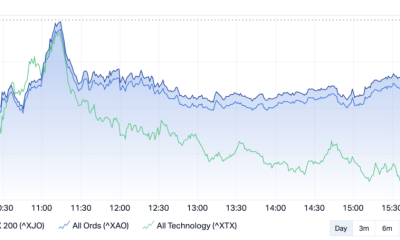Energy & Critical Metals
Charted: America’s Import Reliance of Key Minerals
The U.S. is heavily reliant on imports for many critical minerals. How import-dependent is the U.S. for each one, and on which country?
The post Charted:…

Subscribe to the Elements free mailing list for more like this

Charted: America’s Import Reliance of Key Minerals
This was originally posted on Elements. Sign up to the free mailing list to get beautiful visualizations on real assets and resource megatrends each week.
The push towards a a more sustainable future requires various key minerals to build the infrastructure of the green economy. However, the U.S. is heavily reliant on nonfuel mineral imports causing potential vulnerabilities in the nation’s supply chains.
Specifically, the U.S. is 100% reliant on imports for at least 12 key minerals deemed critical by the government, with China being the primary import source for many of these along with many other critical minerals.
This graphic uses data from the U.S. Geological Survey (USGS) to visualize America’s import dependence for 30 different key nonfuel minerals along with the nation that the U.S. primarily imports each mineral from.
U.S. Import Reliance, by Mineral
While the U.S. mines and processes a significant amount of minerals domestically, in 2022 imports still accounted for more than half of the country’s consumption of 51 nonfuel minerals. The USGS calculates a net import reliance as a percentage of apparent consumption, showing how much of U.S. demand for each mineral is met through imports.
Of the most important minerals deemed by the USGS, the U.S. was 95% or more reliant on imports for 13 different minerals, with China being the primary import source for more than half of these.
| Mineral | Net Import Reliance as Percentage of Consumption | Primary Import Source (2018-2021) |
|---|---|---|
| Arsenic | 100% | China |
| Fluorspar | 100% | Mexico |
| Gallium | 100% | China |
| Graphite (natural) | 100% | China |
| Indium | 100% | Republic of Korea |
| Manganese | 100% | Gabon |
| Niobium | 100% | Brazil |
| Scandium | 100% | Europe |
| Tantalum | 100% | China |
| Yttrium | 100% | China |
| Bismuth | 96% | China |
| Rare Earths (compounds and metals) | 95% | China |
| Titanium (metal) | 95% | Japan |
| Antimony | 83% | China |
| Chromium | 83% | South Africa |
| Tin | 77% | Peru |
| Cobalt | 76% | Norway |
| Zinc | 76% | Canada |
| Aluminum (bauxite) | 75% | Jamaica |
| Barite | 75% | China |
| Tellerium | 75% | Canada |
| Platinum | 66% | South Africa |
| Nickel | 56% | Canada |
| Vanadium | 54% | Canada |
| Germanium | 50% | China |
| Magnesium | 50% | Israel |
| Tungsten | 50% | China |
| Zirconium | 50% | South Africa |
| Palladium | 26% | Russia |
| Lithium | 25% | Argentina |
These include rare earths (a group of 17 nearly indistinguishable heavy metals with similar properties) which are essential in technology, high-powered magnets, electronics, and industry, along with natural graphite which is found in lithium-ion batteries.
These are all on the U.S. government’s critical mineral list which has a total of 50 minerals, and the U.S. is 50% or more import reliant for 43 of these minerals.
Some other minerals on the official list which the U.S. is 100% reliant on imports for are arsenic, fluorspar, indium, manganese, niobium, and tantalum, which are used in a variety of applications like the production of alloys and semiconductors along with the manufacturing of electronic components like LCD screens and capacitors.
China’s Gallium and Germanium Restrictions
America’s dependence on imports for various minerals has resulted in a new challenge resulting from China’s announced export restrictions on gallium and germanium that took effect August 1st, 2023. The U.S. is 100% import dependent for gallium and 50% import dependent for germanium.
These restrictions are seen as a retaliation against U.S. and EU sanctions on China which have restricted the export of chips and chipmaking equipment.
Both gallium and germanium are used in the production of transistors and semiconductors along with solar panels and cells, and these export restrictions present an additional hurdle for critical U.S. supply chains of various technologies that include LED lights and fiber-optic systems used for high-speed data transmission.
The restrictions also affect the European Union, which imports 71% of its gallium and 45% of its germanium from China. It’s another stark reminder to the world of China’s dominance in the production and processing of many key minerals.
The announcement of these restrictions has only highlighted the importance for the U.S. and other nations to reduce import dependence and diversify supply chains of key minerals and technologies.
The post Charted: America’s Import Reliance of Key Minerals appeared first on Visual Capitalist.
manganese
batteries
graphite
rare earths
aluminum
fluorspar
gallium
germanium
indium
niobium
titanium
tantalum

Uranium Exploration Company Announces Additional Staking in the Athabasca Basin
Source: Streetwise Reports 12/22/2023
Skyharbour Resources Ltd. announced an update from its Canada-based Falcon Project along with additional…
Tesla Launches New Mega Factory Project In Shanghai, Designed To Manufacture 10,000 Megapacks Per Year
Tesla Launches New Mega Factory Project In Shanghai, Designed To Manufacture 10,000 Megapacks Per Year
Tesla has launched a new mega factory…
Giving thanks and taking stock after “a remarkable year”
An end-of-year thank you to our readers, industry colleagues and advertisers before Electric Autonomy breaks from publishing until Jan. 2
The post Giving…


















